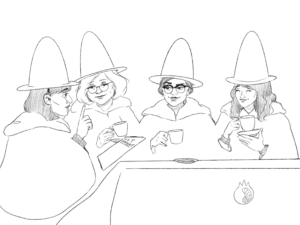Disclaimer: Twin Peeks is a recap/review series about the new season of Twin Peaks — which means there are gonna be spoilers here for everything old and new. If you’re not caught up yet, please do yourself a favor and at least consider it before reading this. If not, you’ll be pretty lost, and you need to get your bearings before diving in. Trust me on this one.
Everything I’ve written so far on Twin Peaks feels insignificant after this week. Maybe my dispatches haven’t been completely meaningless, but they certainly feel lesser-than in the wake of episode eight. A series return that I foolishly thought at first would be a “quiet revolution” literally blew away this idea within the first seventeen minutes of its latest installment. The last few weeks have proven that David Lynch and Mark Frost are building a cohesive narrative, albeit in a radically different way. This week turned this concept up to eleven, and made for the most spellbinding episode of the season so far.
In all fairness, the entirety of The Return has been a challenge to contemporary television. In an era of binge-conscious shows that lean towards quick succession and straightforward structures, this has been truly unique. Twin Peaks has taken its time, unfurling every week unconcerned with the decades of expectations placed upon it. Nearly thirty years later, the very same show that helped lay the groundwork for everything from The Sopranos to Riverdale is rewriting the rules of television yet again.
However, I’m getting ahead of myself. This is a recap after all, and even if it feels futile to attempt to summarize this episode I’m going to try my best. We pick up right where we left off, with Ray and Mr. C on the lam and driving down the highway. After turning off their tracking devices, Evil Coop tells Ray to take a turn off of the road. When they make a pit stop, Evil Cooper attempts to shoot Ray but gets double crossed. DoppelCooper falls to the ground, and that’s when the real fun begins.

Out of the woods comes specters of soot-covered mountain men who surround the body of the Evil Cooper like vultures around a wounded animal. They claw and tear and smear blood as Ray watches in horror. There’s the faintest glimpse at Bob in something they retrieve from the body, but Ray doesn’t stick around to see it. Soon enough he’s off, on the run, and letting Jeffries (that is, David Bowie’s Phillip Jeffries from Fire Walk With Me) know what just happened. Cut to the Roadhouse, where Nine Inch Nails have decided to drop by. Lynch lets a full performance play out for hypnotic effect. We’re being spellbound and by the performance’s end, we’re in too deep. When the next shot shows us Cooper getting up, we don’t have time to react before the cut to black.
What follows is a sensory annihilation, an origin story, and an experimental-horror-meets-b-movie all in one. The next frame takes us back in time to the Trinity test in July 1945; the first time a nuclear weapon was detonated. Scored to “Threnody to the Victims of Hiroshima,” the scene explicitly ties one of humanity’s greatest sins to the birth of the most iconic and terrifying entity in Twin Peaks. As we descend through the mushroom cloud and frames of mesmerizing visual static, we eventually come across the monster we saw in New York vomiting a gooey-egg stream. Nestled with all the rest of her creations is an obsidian orb with Bob’s smiling face on it. Humanity has been implicated in this; we have brought this unspeakable horror into the world, and now we must pay.
Duality has always been a major theme in Lynch’s work, so it makes sense that this episode would have an answer for evil-incarnate Bob. The Giant (Carl Struckyen) and a lady accompanying him listed as Señorita Dido in the credits, witness the birth of Bob (from what could potentially be the White Lodge) and take action. The Giant levitates and gold dust spills out of his mouth. Eventually, a golden orb with Laura Palmer’s face emerges and it is sent into the world. It took my breath away. Aside from being gorgeous, this scene would explain the literal, life-long struggle between Bob and Laura — a conflict that transcends time itself. It also raises questions about Laura and her place in all of this. She’s always been the heart of Twin Peaks, but positioning her as a potential savior is a development that had never crossed my mind. For now, I’ll be waiting until we get any further answers about this in future episodes (but I doubt it).

Eleven years later, in another New Mexico desert, a locust-frog hybrid hatches and begins to crawl blindly on the sand. At the same time, a young girl is walking home from a date, and the Woodsmen who harvested the remains of Mr. C have begun to terrorize unsuspecting residents. This all comes together when one of the Woodsmen strolls into a local radio station, chanting the repeated refrain “Got a light?” When the horrified secretary he meets first stares in horror and doesn’t answer, he places his hand on her head and squeezes until blood flows down her face. The DJ playing The Platters’ “My Prayer,” meets a similar fate as the Woodsman cuts the music and grabs the mic. The inky black figure begins speaking. “This is the water and this is the well/Drink full and descend/The horse is the white of the eyes and the darkness within/Drink full and descend.” Everyone in range of the signal descends rapidly into a deep sleep, including the girl from earlier. What about the locust-frog? It’s crawled all the way to its destination — the teenage girl’s bedroom window. As she sleeps, the creature approaches and crawls neatly into her mouth.
There have been a number of terrifying things showcased in Twin Peaks, but this last section of episode eight is something else entirely. I wouldn’t be surprised if the Woodsman made an appearance in my next nightmare, in all honesty.

No matter the specifics of the plot in last week’s episode, one thing was abundantly clear: David Lynch is a master of bringing emotions to full scale on screen.
Shame, terror, hope — these are all immense feelings and Lynch dives directly into them. We may not understand what’s going on here at a surface level most of the time (I know that I’m often at a loss), but we understand the wrench in our gut when the bomb lights up the screen. We understand the shiver that runs down our spine as the Woodsman chants into the night. We understand that despite humanity’s capacity for evil there is a warmth present when the golden orb floats out of the Giant and into space. After all, who can argue with a feeling?
Maybe this coming week’s hiatus is a blessing after all of this. I know I’m thankful to have time to fully process it all, but it’ll still be tough to sit with the weight of episode eight for another week. I don’t even know what to expect when we make it to the halfway point of the season on July 9 (the tagline: “This is the chair” doesn’t help much), but I’ll be here to try and make sense of it with you all the same. Until then, drink full and descend.




